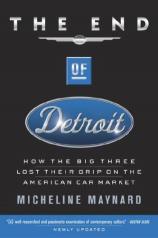Excerpt
Excerpt
The End of Detroit: How the Big Three Lost Their Grip on the American Car Market

A light fog enveloped the Detroit area on Sept. 3, 2003, as thousands of commuters made their way into auto plants, company offices and industrial parks. Thanks to an early Labor Day holiday, that Wednesday morning, for many, was only the second day back after summer vacation. So a relaxed atmosphere was still in the air. Few people had any sense that by the end of that late summer day, the American automobile industry would be changed forever. By mid-afternoon, e-mail traffic was flying thick and fast across the country and around the world, as the August results were made public. An email sent by Ron Pinelli, an industry analyst with Autodata Corp. in Woodcliff Lake, N.J., whose firm tracked monthly sales results, summed it up. It read: "The big news is that Toyota beat Chrysler."
No earthquake could have rattled Detroit more. For the first time since Toyota began selling cars in the United States more than four decades before, it had taken the No. 3 position in American car and truck sales. After the most aggressive August sales campaign the industry had ever seen, Toyota's sales for the month topped 200,000. That was 10,000 more cars than Chrysler, whose sales had been sliding all year, due to a stale lineup and a reluctance to match the hefty rebates and interest-free loans that other Detroit companies were offering. Chrysler's chief executive, Dieter Zetsche, had dubbed such deals "automotive heroin." But without them, Chrysler could not keep pace. And as a result, that month Detroit's automakers no longer comprised the country's Big Three carmakers. The lineup was General Motors, Ford and Toyota.
That was not the only bad news for Detroit companies. That August, their combined share of the American car and truck market that month had fallen to just 57%, a level they had not seen since 1981. That gloomy, 50,000-foot figure was what the Detroit News chose to make the lead of its story, splashed the next day across its front page. But editors at the Detroit Free Press, and countless newspapers around the country saw it otherwise. The next morning's New York Times story, datelined September 3, began like this: "The day that the American automobile industry has been dreading for years arrived today. Toyota outsold Chrysler, the first time one of Detroit's Big Three has fallen to fourth place."
The news, though monumental, was not completely unexpected. A few months earlier, Toyota had come within about 5,000 sales of Chrysler for that month, and it had ended 2002 as close to Chrysler as it had ever been, less than 500,000 sales apart for the year. At an industry conference in August 2003, David Cole, the veteran automobile industry expert whose father, Ed, had been president of General Motors, proclaimed that the industry in essence consisted of a Big Two -- meaning GM and Toyota. Yet, Toyota executives, famed for an outward modesty that camouflaged an unflinching ambition, insisted that the company's goal was not to pass Chrysler, only to please customers. Whether it wound up beating Chrysler was irrelevant, as long as buyers were content, they maintained.
Other executives in the industry, and indeed, even some within Toyota, argued that any Toyota victory would be only a partial one. That was because Toyota's monthly sales figures included those of Lexus, its luxury brand, while those at Chrysler included only its traditional brands -- the Chrysler division, Dodge and Jeep. If Chrysler were to include Mercedes-Benz, the luxury carmaker owned by its German parent, DaimlerChrysler, then Chrysler easily kept its lead. But at the outset of the merger between Chrysler and Daimler-Benz in 1998, which was meant to create the world's first truly global automaker, DaimlerChrysler officials emphasized that there were no plans to combine the American carmaker and the German luxury company. They were to remain separate, with separate marketing approaches and separate sales reports, even though GM and Ford had always folded the sales of Cadillac and Lincoln respectively into their monthly reports, along with those of their other luxury marks.
When it came time to explain what happened with August sales, Chrysler officials seemed sanguine. They certainly gave no sense of the historic event that had just transpired and if they felt rattled, they did not show it. "Nobody's going to question the fact that Toyota's having a great run in the U.S. car and truck business right now," said Chrysler vice president Gary Dilts, in what was clearly the understatement of the day. The emphasis at Chrysler, which lost $900 million in the 2003's second quarter, would be on "selling cars and trucks profitably," he said. Speaking about the event six months later, CEO Zetsche was equally blasé. "It was much more of a media event than it was an event for us," he maintained.
But on that September day, Toyota for once, was not modest. James Press, chief executive of the company's American sales operations, said the sales report was inevitable. ""This was a day that had to happen. I'm glad it happened," said Press, who had joined the company in 1970. But he did not predict more monthly victories in the near future - in part because the flurry of sales had exhausted Toyota dealers' supply of vehicles. "Next month, they may beat us," Press said.
In fact, Chrysler did beat Toyota in October 2003 and maintained its lead, though often a slim one, over Toyota in the following months. Yet that September afternoon would not quickly be forgotten, in Detroit or elsewhere in the industry. Toyota's victory over Chrysler was the most visible sign yet that Detroit's long grip on the American car market had been lost. But it was far from the only such evidence.
Excerpted from THE END OF DETROIT: How the Big Three Lost Their Grip on the American Car Market © Copyright 2004 by Micheline Maynard. Reprinted with permission by Currency/Doubleday, a division of Random House, Inc. All rights reserved.
The End of Detroit: How the Big Three Lost Their Grip on the American Car Market
- Genres: Business, Nonfiction
- paperback: 368 pages
- Publisher: Crown Business
- ISBN-10: 0385507704
- ISBN-13: 9780385507707



